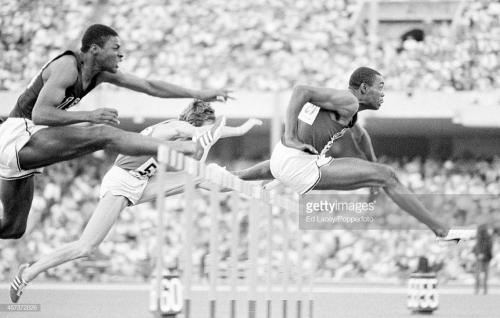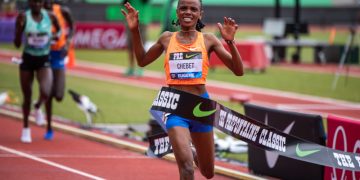This is day 5 of the feature series written by Mike Fanelli, titled The 1968 Mexico Olympics Reconsidered. This is the repost on the 54th anniversary of the Mexico Olympics.
This is day five of Mike Fanelli’s salute to the 1968 Mexico Olympics. Mike has taken us back fifty years ago today, Wednesday, October 17, 2018. Mike writes about the 110m hurdles, 5000 meters, Triple Jump, and the 50,000m race walk.
The editor of RunBlogRun was able to meet two-time Olympic bronze medalist Larry Young at the 50k RW just a few years ago. In my collection of photos is quite modest when compared to Mike Fanelli’s Track Garage. A photo from the 1976 Olympics of Willie Davenport (bronze medalist) with France’s Guy Drut, 110m hurdle 1976 gold, sharing a cigarette break post-event.
Willie’s Full Nelson...The fifth day of athletics at these 1968 Mexico City Olympic Games offered the rabid track & field fan a wide variety of finals…110 hurdles, 5,000-meter run, triple jump, and lengthiest endurance contest on the docket, the 50-kilometer racewalk. As though the altitude and hills weren’t large enough obstacles, the 31+ mile event started late on this quite warm Thursday afternoon. As most stamina events tend to become, it was a race of attrition. More than four hours after he started, the dominant East German, Christophe Hohne, emerged from the stadium’s tunnel and rolled onto the tartan track, fully ten minutes clear of his nearest competitor. Meanwhile, back out on the race course, Larry Young, a Missouri native who had attended Columbia College on a racewalking scholarship, was picking off road kill. He was just a very patient 10th at the 20K mark, yet, stuck with his game plan. “I knew my strategy of pacing to the 20 and holding on and bearing down at the 30 would pay off”, said Young. Second, into the stadium was Hungarian Antal Kiss, and much to the surprise of nearly every aficionado, the plain white tee-shirt-wearing Young strolled in at the third spot. In the final loop of the track, his form was flawless as he closed in on but missed the goulash guy. Larry Young’s bronze was the first-ever American racewalk medal of any color. He would repeat that trick again four years later and remains to this day, the only USA holder of Olympic hardware in either the 20K or 50K disciplines.
Concurrently, on the infield, the hop, skip, and jump title was being contested…and it was a good one. Before 1968, the 55-foot mark had only been bettered twice. At these Games, that standard of excellence was pummeled no fewer than 14 times. When the sand cleared, the aptly named winner, Victor Saneyev of the Soviet Union, took home the European record, the Olympic record, and a new world record (57′ 3/4″) to go along with his well-deserved gold medal. The top American, Art Walker bounded to a lifetime best by more than half a foot (56′ 2″ w) but had to settle for the unkindest place of all, fourth.
The day’s long-distance track event was 12.5 circuits in distance, only one-tenth as long as the racewalk. There’d be no Americans lining up for this one. Their presence would have been compromised anyways by the more than 1.3 miles high elevation of this extraordinarily unlevel playing field. Only the ‘once a Michigander’, Jack Bacheler, who cruised to an easy breezy 4th place in the qualifying round, would earn a lane in these finals. Bob Day would not…nor would Lou Scott. Regrettably, Mexico’s Mister Montezuma made mayhem of the Miami alum’s innards, and he’d therefore be relinquished to the sidelines of this 5,000 finale.
To call the first lap timid would be a gross understatement, as the split timers had to double-check their chronographs which had recorded a 72. They were 4:32 after four laps but then bunched up again on the fifth go-around, which devolved into a 71.3. Although highly disadvantaged, at about 9 laps in, Ron Clarke, the world record holder at 13:16.6, took ‘charge’…for a mere nano-second. Here’s where Mohamed Gammoudi moved to the front. A local favorite, Juan Martinez, came up alongside Clarke (who was now in second), and the 10K Kenyan champ, Naftali Temu, was neatly tucked in at the fourth position. Coming from a ways behind, Kipchoge Keino made his move from 600 meters out. As he pulled abreast of Gammoudi (who had recently acquired a 10,000-meter bronze medal), the terrific Tunisian glanced right and then promptly denied access. At the bell, Temu tried to pass, but the stubborn leader also fought him off. The backstretch fight was ferocious and just this side of fisticuffs, but again the plucky North African was relentless. Instead, he leaned into the final curve and created a bit of short-lived separation. Meanwhile, Kip eked past Naftali and, with just 40 meters to go, hurled himself even Steven with the leader. But Gammoudi still refused to crack, and despite the Kenyan’s 54.8 closer, Gammoudi grabbed gold by 4 meters, maybe 5.
Once the high hurdles crew completed their tedious setup, eight athletes in multinational warmup togs were beckoned by the announcer’s final call. A third of them were bedecked in blue with red and white trim. Team USA would line up in lanes four (Willie Davenport), six (Erv Hall), and seven (Leon Coleman). Davenport spent most of the season big-time injured. He rebounded well enough in late summer to seal his spot on the team.
A deafening hush came across the stadium at large, and then the starter’s cannon fired. Willie D wasted nary a spare 1/100th and was clearly the first man out. Sage track reporter, Don Potts, recalled: “Willie ended the race at the gun, getting a superb start that gave him an immediate lead.” His teammates, too, were off nicely, and the possibility of a sweep clearly loomed. Italian Eddy Ottoz gamely gave chase. Coleman clipped hurdle six, and the Paesano passed. The Southern University star proceeded unimpeded and won it wire-to-wire in a convincing 13.3. Not only did he strangle the field, but he also wrecked the previous Games record by a marked 15% (13.5 in 1956). Villanovan, Hall nabbed silver, Ottoz bronze, and then came Coleman, who was two-tenths shy of the podium step..
Postscript: Willie Davenport is the answer to one of my favorite track trivia questions: name the one American track athlete that represented the US in the 1980 Olympic Games… ’twas Davenport in the bobsled at the pre-boycott Winter Games.























